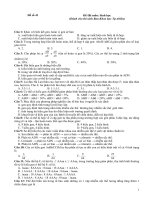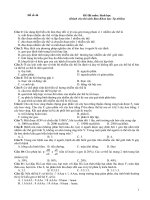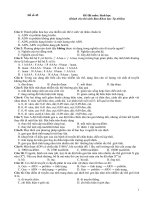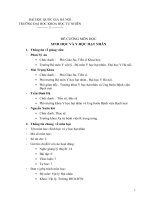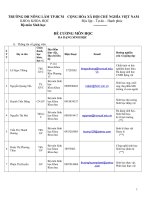Sinh hoc CDDH
Bạn đang xem bản rút gọn của tài liệu. Xem và tải ngay bản đầy đủ của tài liệu tại đây (1.61 MB, 21 trang )
Darwin & Natural
Selection
```
Charles Darwin
(1809-1882)
Lecturer: PhD.La Viet Hong
Presented by:
1.Nguyen Phuong Thao
2.Le Minh Tuan
3.Tran Thi Huong
4.Nguyen Tu Huong
Charles Darwin
-Charles Robert Darwin (1802-1882).
-He is father of Evolution.
-Proposed a mechanism for evolution, natural
selection
-Darwin went on a 5-year trip around the
world on the ship, the HMS Beagle
-As the ship’s naturalist, he made
observations of organisms in South America
and the Galapagos Islands.
-Darwin published his book «On the Origin of
Species by Means of Natural Selection» in
1859.
What is the natural selection ?
A process through which species that are best suited to
their environment survive and reproduce at a higher rate
than other members of the species.
What is the object of natural selection ?
It is individual and population
The essence of Darwin’s theory of natural selection
(1) Variation exists in natural populations
(2) Many more offspring are born each
season than can possibly survive to maturity
(3) As a result, there is a struggle for
existence
(4) Characteristics beneficial in the struggle
for existence will tend to become more
common in the population, changing the
characteristics of a species
(5) Over time, and given a steady input of new variation into
a population, these processes lead to the emergence of
new species
What are the four parts of natural selection?
Darwin’s Theory of Natural Selection occurs in
four steps:
1.
2.
3.
4.
Overproduction
Variation
Variation
Selection
Overproduction
Each species produces more offspring that can
survive
Variation
Each individual has a unique combination of
inherited traits.
Adaptation: an inherited trait that
increases an organism’s chances of survival
Competition
-Individuals COMPETE for limited resources:
food, water, space, mates.
-Natural selection occurs through “Survival of
the fittest”
Fitness: the ability to survive and reproduce
-Not all individuals survive to adulthood
Selection
-The individuals with the best traits / adaptations
will survive and have the opportunity to pass on it’s
traits to offspring.
+Natural selection acts on the phenotype (physical
appearance), not the genotype (genetic makeup)
+Example: When a predator finds its prey, it is
due to the prey’s physical characteristics, like color
or slow speed, not the alleles (BB, Bb).
-Individuals with traits that are not well suited to their
environment either die or leave few offspring.
-Evolution occurs when good traits build up in a
population over many generations and bad traits are
eliminated by the death of the individuals.
The result of natural selection
From 1 species to 14 species…
-The survival of the most adaptive individuals or the formation of
Warbler finch
Cactus finch
adaptive features of the organisms
Woodpecker finch
Small
ground
finch
Cactus
eater
s
he
nc
Tre
e fi
nc
he
s
Warb
finch
fi
nd
ou
Gr
Small
insectivorous
tree finch
Large
insectivorous
tree finch
Sharp-beaked
Formation
of finch
new species
N
se atur
lec al
tio
n
ler
Insect eaters
Seed eaters
Vegetarian
tree finch
variation
Bud eater
natural selection for best
survival & reproduction
Medium
ground
finch
Large
ground
finch
The role of natural selection
How many are type of natural selection?
The natural slection has 4 type:
1. Stabilizing selection
It occurs when the intermediate or average form of
a trait is selected. Stabilizing selection operates to
eliminate extreme traits.
2. Directional selection
Directional selection is when one extreme form of a trait
is favored or selected.
3.Disruptive Selection
Disruptive Selection is
a form of selection that
selects for the two
different extreme forms
of a trait and selects
against the average form
of a trait.
In this example, both
extremes use mimicry as
a camouflage strategy
4. Sexual selection
-Some forces of selection do not enhance an organism's
fitness or ability to survive, but rather advertise an
organism's health or dominance.
-This type of selection is called sexual selection
Frequency of
individuals
Original population
Original
population
Evolved
population
Stabilizing selection
Phenotypes (fur color)
Directional selection
Disruptive selection
The Hardy-Weinberg Principle
In 1908, English mathematician Godfrey
Hardy and German physician Wilhelm
Weinberg developed an equation that
demonstrates how allele frequencies will
most often remain stable unless acted
upon by certain outside forces or
circumstances.
In other words, they mathematically
demonstrated how and when natural
selection takes place.
The Hardy-Weinberg principle can be
written algebraically by the following
Hardy Weinberg Equation

